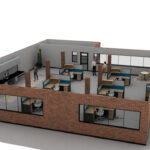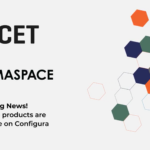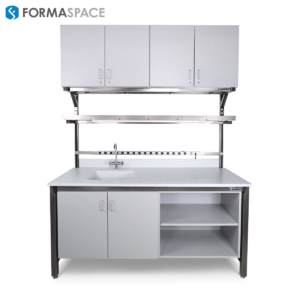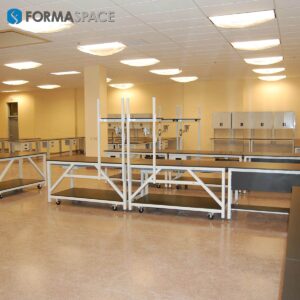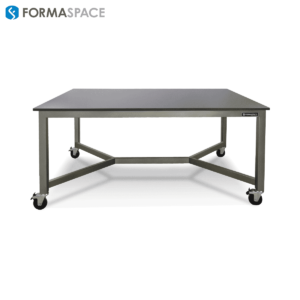Earlier in December, we introduced you to Chris Andrews, who came on board from Hamilton Scientific to serve as Formaspace Vice President of Sales. This week we like you to meet some of the key operations and engineering staff at Formaspace: Bill Lambert and Greg Casey.
First, Let’s Introduce You to Bill Lambert, Formaspace Operations Manager
Bill Lambert joined Formaspace just last August; Bill comes to us from the pharmaceutical, medical devices and food grade manufacturing industries. As you may have read, Formaspace had record sales in 2013 and, as we expand into serving larger enterprise-level companies, we expect our sales revenue to triple in the next few years. So Bill has been tasked with a very good problem to have: how to manage Formaspace’s furniture manufacturing production during a period of steadily increasing sales growth.
Q: Bill, what’s your approach to managing operations at Formaspace?
It really starts with people. One of the key areas for me is creating close, cohesive teams. I’m really pleased to see we have that kind of team spirit at Formaspace. Like many of the people here, I have a technical background, but also a strong entrepreneurial spirit.
Q: So you sound pretty enthusiastic about Formaspace!
Yes! I love building things, manufacturing things. And what’s great here is that, if you can dream it, we can build it. It’s an exciting place to come to work every day. The company has great culture. And I love our approach to customer service. That starts at the top with Jeff Turk, our CEO and founder. He really believes in making the customer happy.
Q: Do you have a particular philosophy or approach to operations and supply chain management?
Yes, without getting caught up in what I guess you could call “consultant dogma”, you could say I approach operations with an eye toward employing Six Sigma principles, that I’m oriented toward Lean Manufacturing and that I am a big proponent of the 5S’s.
Q: I thought I knew a fair amount about supply chain management. What are the 5S’s ??
I guess I caught you off guard! Those are principles that are part of Kaizen (改善) which is Japanese for “improvement” or “change for the best”— more commonly known as Continuous Improvement here in the US. The 5S methodology comes from these Japanese words, seiri, seiton, seiso, seiketsu, and shitsuke. It’s an approach that is part of Lean Manufacturing.
Q: Oh ok. I read a book about W. Edwards Deming, who went to Japan after World War II to teach quality methods, but I don’t recall 5S. Can you give me an example of using 5S at Formaspace?
Sure, I have a perfect example: by using 5S methodology, we were able to recapture 7500 ft.² of warehouse space inside our 60,000 ft.² building.
Q: Wow that’s impressive! Are you busy organizing things in your spare time? (I’m thinking about inviting Bill to come over and organize my garage…)
Indeed I do! I’ve got a wife and four kids aged 2, 4, 8 and 10. Plus, I’m a Cub Scout leader and sports coach for our kids’ league. If all that doesn’t require organization, what does?
Q: No doubt! Are you an Austin native as well?
I’m a native Texan, from Stephenville, which is northwest of Austin. I graduated from the University of Texas here in Austin, where I studied biology. I guess little bit of Austin has rubbed off on me, I really love live music, going out when we have time and I enjoy playing the guitar, even if those around me, including my wife, don’t seem to appreciate my playing all that much.
Q: Thanks for the interview Bill and we look forward to learning more as Formaspace expands its operations.
Anytime! We have a lot to tell our customers about our operations. One of the best ways we do that is with one of our factory tours. Just give us a call and we’d be pleased to show you our facility.
Next Up We’d Like to Introduce Greg Casey, Formaspace Director of Design

Q: So welcome Greg, thanks for taking time away from the design team to talk with us today. Tell us about how your career in the furniture industry got started.
Thanks! Well, I’m the guy you always hear about who started on the shop floor and worked their way up into engineering/design management.
Q: Yes, I’ve heard about you! The Horatio Alger story… Tell us the details.
Well, I’m a Midwestern guy, born in southern Indiana. Kimball was the large employer in the region and I took a job on the factory floor right out of high school. It was a fantastic experience for me. I was able to learn everything from the ground up, experiences that I took with me as I advanced in different areas within furniture production at Kimball. In the evenings I was able to take classes at Purdue University and earn my college degree. I became a Product Engineering Manager and then rose to the rank of Director Product Engineering.
Q: It seems like a perfect fit for you. Are you busy with mechanical hobbies outside of work as well?
You bet. My passion is motorcycles. I’ve customized just about every model of Harley over the years. My wife of 18 years has come to accept that I’m happier when I’ve got the opportunity to ride the bike.
Q: But what about the winter weather in Indiana? No motorcycle riding up there this week.
Yes, that’s one of the great things about relocating to Texas. I can ride nearly all year long in this climate. It was a big change but all of us are getting used to the move. My wife teaches second grade and our two kids have settled into their new school system.
Q: It looks to me you’ve also kept up with the latest lean production strategies and software technologies.
You have to. You can’t keep up the level of quality without these modern systems. My team’s customer — internally speaking — is Bill Lambert, with whom you spoke earlier. Bill and I share a passion for lean manufacturing so you’ll hear us talk a lot about things like ‘value stream mapping’, ‘quality audits’, ‘touch for quality’ and ‘continuous improvement.’ We should talk about these things in a future article but for now what I’d like to say is our internal quality levels are rising even as our production levels are going up significantly. The expectations of the market are changing as well.
Many of our enterprise level customers in the AEC (architecture engineering construction) market are deploying REVIT software from Autodesk to map out entire large-scale office towers, schools, government/military facilities and other projects in 3D. These CAD projects are hugely detailed, right down to the exact placement of the electrical and plumbing. We’ve been using REVIT as well and now we’ve started exchanging REVIT furniture files with our customers so they can drag and drop things like Formaspace casework, industrial workbenches, shelving systems and lab furniture — you name it — right into their 3D REVIT environments. This is a very efficient workflow for us and for our customers, and it gives us both a competitive advantage over the competition.
Q: I know our customers and prospects will be glad to know we have this capability of integrating REVIT files. What else should they know about Formaspace?
I could go on and on! The fact is this company is chock full of good people. I love the way Jeff Turk (Formaspace founder/CEO) does business. He does what he says. That means a lot to me. Plus the opportunities for exponential growth are here and that makes it an awesome place to work. I’d also like to come back to you with some more updates on the team; we are developing our own industrial design team to support customers.
We’re also raising the level of our customer service programs with an experienced group of mechanical engineering and IT staff. Finally, one idea I think customers would be interested in is how the whole production process works, from the customer’s initial inquiry, to design, to production, to delivery and to the final installation on site.





